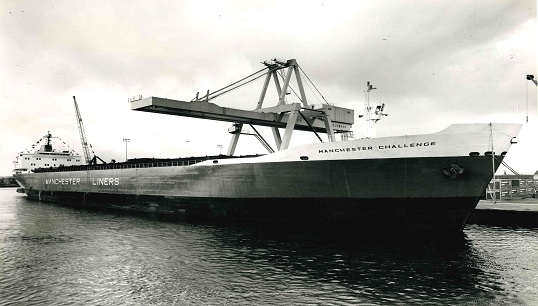Manchester Challenge

The build
Manchester Challenge was launched at the Smith's Dock Company South Bank yard on the Tees in June 1968 and was the first of four vessels ordered by Manchester Liners following a decision to containerise all of its shipping operations.
The vessel weighed 11,899 grt with a loa of 530ft, and it and could carry just over 500 30ft containers in five cargo holds. Manchester Challenge was powered by a pair of 18-cylinder Crossley-Pielstick medium-speed engines with a combined output of 16,380bhp, giving the single-screw ship a service speed of 19.5 knots.
The ship had a high degree of automated systems for its time and was equipped with bow cameras, bridge-controlled anchoring, covered mooring stations and slam indicators, as well as special arrangements to facilitate engineroom maintenance, which were based around the regular use of riding gangs.
The vessel was designed to operate with a crew of 28 and had a high standard of accommodation, with individual cabins for up to 34 people. The ship's first master was Captain Phillip Fielding, a Manchester man who had first gone to sea in 1940 and had previously held the command of five Manchester Liners vessels.
To ensure the vessel was able to withstand the St Lawrence Seaway ice and provide a year-round service, Manchester Challenge featured additional aft protection over the rudder to enable the vessel to be reversed through ice.
The Manchester Challenge and its sisterships were of Manchester Canal-max dimensions, and their entry into service came at a time of increasing speculation about the future viability of the waterway and Manchester's position as Britain's third-largest port.
Manchester Challenger and two of its sisterships were modified in the early 1970s to enable the carriage of 40ft containers.
Deployments
Manchester Challenge and sisterships Manchester Courage, Manchester Concorde and Manchester Crusade had been ordered by Manchester Liners as part of an ambitious £100m programme that also included the construction of new cargo handling facilities in Manchester and Montreal.
The four ships operated a new twice-weekly service to Montreal, where containers were transferred to railways and to smaller feeder ships running to other Great Lakes ports.
In 1975, Manchester Challenge completed its 100th voyage to Montreal, having carried 95,000 containers and covered a distance of 554,000 miles.
Ownership
By the late 1970s, competition and the growth of containership capacity were undermining the economics of Manchester Challenge and its sisters.
Manchester Challenge was replaced by the much larger Dart America, which could carry three times as many containers, and sold in 1978 to Hong Kong Shipping Company, re-flagged to Panama and renamed Ocean Container. The vessel was then sold to the Mediterranean Shipping Company in 1989 and renamed MSC Susanna, remaining in service until being sent for demolition in Chittagong in May 1993.
Manchester Challenge Fact File
How big was the Manchester Challenge?
The Manchester challenge had a grt of 11,899 with a loa of 530ft
When was the Manchester Challenge launched?
The Manchester Challenge was launched in June 1968 at the Smith's Dock Company South Bank yard on the Tees
How many sisterships did the Manchester Challenge have?
The Manchester Challenge had three sisterships: the Courage, Concorde and Crusade
Contribute
Are you knowledgeable about this vessel?
Submit your contribution to this article to our editorial team.
Write to usView more ships of the past
HMS Beagle
Launched 200 years ago, HMS Beagle has been described as one of the most important ships in history – thanks to the observations on evolution and natural selection that its famous passenger Charles Darwin made during a five-year voyage around the world between 1831 and 1836.
Common.ReadMoreHMS Beagle
Megara
Originally constructed as an oil tanker in 1929, the Dutch ship Megara went on to become one of the first specialist liquefied petroleum gas (LPG) carriers only five years later.
Common.ReadMoreMegara
Malakand
Launched in November 1918, the Malakand was a sistership to three other vessels and was fitted to train cadets until the shipping slump of the 1920s. With an uneventful early career, the Malakand later became the victim of Liverpool's May Blitz in 1941.
Common.ReadMore